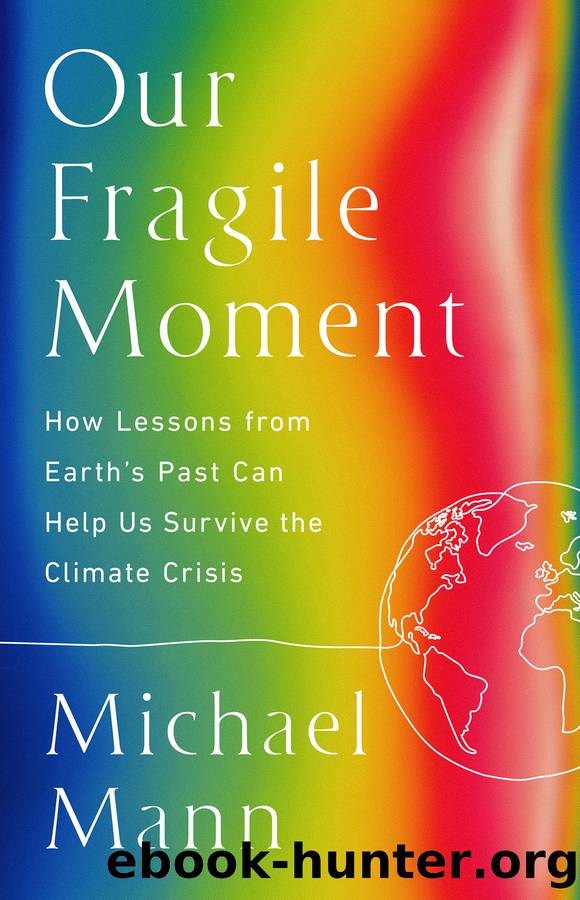Our Fragile Moment by Michael E. Mann

Author:Michael E. Mann [E., Michael Mann]
Language: eng
Format: epub
Publisher: PublicAffairs
Published: 2023-09-26T00:00:00+00:00
The Pleistocene Glaciations
Carbon dioxide levels and global temperatures continued to drop as we transitioned from the Pliocene into the Pleistocene, a little more than 2.5 million years ago. Paleoceanographers think that the formation of the Isthmus of Panama about three million years ago, which blocked the flow of relatively fresh seawater from the Pacific Ocean to the Atlantic Ocean, led to the salinification of the Atlantic, a stronger ocean conveyor circulation, and a greater transport of snowfall-generating moisture to the high latitudes of the North Atlantic. The key factor, though, as weâll see, was the effect of continued drawdown of atmospheric CO2, consequent cooling, and its impact on the behavior of increasingly large continental ice sheets.17
With an ice sheet already having taken hold in Greenland, ice began to spread southward into North America and northeastern Europe, giving us the Laurentide and Fennoscandian Ice Sheets, respectively. At its peak the Laurentide Ice Sheet (LIS) covered all of Canada and parts of North America as far south as southern Illinois and Indiana, New York City, and the northern half of my state of Pennsylvania. The Fennoscandian Ice Sheet (FIS) covered modern-day Scandinavia and neighboring regions of northern Europe.
These ice sheets waxed and waned over tens of thousands of years with the Earthâs orbital cycles. The changes in ice volume are documented by oxygen isotopes from deep-sea sediment cores. We learned in earlier chapters that the ratio of stable oxygen isotopes (oxygen-16 to oxygen-18) in the preserved shells of calcareous biota varies with sea temperaturesâbeing relatively depleted in oxygen-18 for warmer ocean temperatures. But we alluded to one complication: the ratio also depends on global ice mass. For hothouse climates, this is an insignificant factor, but for icehouse climates like the Pleistocene, it can be the dominant one. Yet, this is, as they say, a feature, not a bug, for it allows us to document the changes in global ice mass over time.
As we learned earlier, oxygen-18 is enriched in seawater (and thus calcite shells) when ice sheets form and grow. Because cold oceans and large ice sheets go together climatically, and each is characterized by enriched oxygen-18, a very clear and unambiguous signal of glacial cycles is captured by the oxygen isotope data.
The oxygen isotope data show a steady, long-term trend toward colder, icier conditions over the course of the Pleistocene. For the first million or so years, we see an oscillation between colder, icier (glacial) states and warmer, less icy (interglacial) states. The oscillations occurred with a roughly 40,000 year pacing, which we know is tied to the tilt angle of Earth relative to its orbital plane. As we learned in Chapter 1, the tilt angle today is about 23.5 degrees from vertical. However, the angle changes over time, between about 22 degrees and 24.5 degrees. On the low end, this means cooler summers and warmer winters at high latitudesâan ideal combination for the buildup of ice sheets, as warmer winters can increase the accumulation of snow while cooler summers reduce the amount of summer melt.
Download
This site does not store any files on its server. We only index and link to content provided by other sites. Please contact the content providers to delete copyright contents if any and email us, we'll remove relevant links or contents immediately.
How to Do Nothing by Jenny Odell(2651)
A Forest Journey by John Perlin(2588)
The Plant Messiah by Carlos Magdalena(2458)
Babylon's Ark by Lawrence Anthony(2073)
Energy Myths and Realities by Vaclav Smil(2066)
The ESV Study Bible by Crossway Bibles(1954)
Abbey in America by Murray John A(1810)
Fatal Storm by Rob Mundle(1792)
Witness Tree by Lynda V. Mapes(1698)
Shadows on the Gulf by Rowan Jacobsen(1520)
Client Earth by James Thornton(1506)
Brokeback Mountain by Annie Proulx(1473)
Coming Back to Life by Joanna Macy(1467)
Water Rights and the Environment in the United States by John Burch(1415)
Cosmos by Carl Sagan(1404)
Ten Billion by Stephen Emmott(1384)
Mycelium Running: How Mushrooms Can Help Save the World by Paul Stamets(1290)
The overachievers by Robbins Alexandra(1287)
The Uninhabitable Earth by David Wallace-Wells;(1196)
